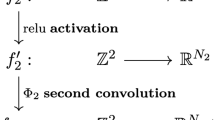Abstract.
We present a new theoretical framework for multidimensional image processing using Clifford algebras. The aim of the paper is to detect edges by computing the first fundamental form of a surface associated to an image. We propose to construct this metric in the Clifford bundles setting. A nD image, i.e. an image of dimension n, is considered as a section of a trivial Clifford bundle \((CT(D), \widetilde{\pi}, D)\) over the domain D of the image and with fiber \(Cl({\mathbb{R}}^n, \parallel\parallel_2)\). Due to the triviality, any connection \(\nabla_1\) on the given bundle is the sum of the trivial connection \(\widetilde{\nabla}_0\) with ω, a 1-form on D with values in End(CT(D)). We show that varying ω and derivating well-chosen sections with respect to \(\nabla_1\) provides all the information needed to perform various kind of segmentation. We present several illustrations of our results, dealing with color (n=3) and color/infrared (n=4) images. As an example, let us mention the problem of detecting regions of a given color with constraints on temperature; the segmentation results from the computation of \(\nabla_1(I) = \widetilde{\nabla}_0(I) + (dx+dy)\otimes\mu{I}\), where I is the image section and μ is a vector section coding the given color.
Similar content being viewed by others
Author information
Authors and Affiliations
Corresponding author
Rights and permissions
About this article
Cite this article
Batard, T., Berthier, M. Clifford Algebra Bundles to Multidimensional Image Segmentation. Adv. Appl. Clifford Algebras 20, 489–516 (2010). https://doi.org/10.1007/s00006-010-0207-y
Received:
Accepted:
Published:
Issue Date:
DOI: https://doi.org/10.1007/s00006-010-0207-y




